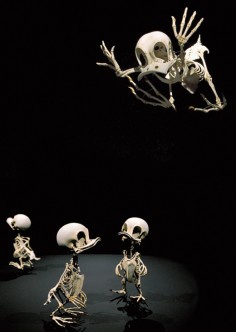HYUNGKOO LEE
이형구
Хюнгко Ли
Lepus Animatus
source: youcreatives
Unique work by Seoul based artist Hyungkoo Lee.
The korean artist extends his concerns to fictitious bodies of cartoon characters by inventing their fossil bones in a quasi-archaeological way.
.
.
.
.
.
.
.
source: artinasiakr
Hyung koo Lee(born 1969) has a B.F.A. from Hong-ik University(1998) and a M.F.A. from Yale University(2002). In the same year he was awarded the Joan Mitchell Foundation Award and continued to work in New York. He came back to home in 2003 in order to take part in the Ssamji Residence program, starting his line of work in Korea and his first solo exhibition ‘The Objectuals’ held at the Sungkok Museum(2004) received much attention. In 2006, his second solo exhibition ‘Animatus’ was held at the Arario Gallery and afterwards was selected as the only artist in Korea to participate in the Venice Biennale making it his third solo exhibition. The talk of the world was that this artist has held only two solo exhibitions and is much too young to be selected. However, Lee responded that the number of solo exhibitions does not determine an artist’s quality of artwork and also remarked that the methods and strategies that every artist possesses widely varies.
He affirmed that in his first solo exhibition, 5 years of strenuous work was displayed and in his second exhibition, he used ideas that were cultivated since 2000 and labor-intensively finished his work after two years. In this Venice Biennale, ‘The Objectuals’ series and ‘Animatus’ series along with a new piece of artwork are all going to be shown. At the same time, memos, drawings, materials, bone fragments and the documentations of his working process with new film work which will compliment the two series will be on display. Also, a performance on the opening day of the Korean pavilion is scheduled. He got us curious for it and of the happening as he implied serene things might be more impressive.
.
.
.
.
.
.
.
source: nnmru
Корейский скульптор Хюнгку Ли никогда не расщеплял атом, не создавал космических кораблей и не нырял в глухомань человеческого ДНК. Он художник, а не ученый. Несмотря на сей факт, его искусство имеет к науке непосредственное отношение. Оно питается фантазиями прагматичных романтиков в белых халатах, смешивает их с поп-артом, современной скульптурой и футуристическим мышлением о межгалактическом грядущем.
И пока искусствоведы ищут подходящий термин для определения творческих практик Хюнгку Ли (художественная наука или научный-фикшн?) зритель без лишних вопросов погружается в пространство визий о будущем, где крошка-гражданин непременно станет космическим путешественником или археологом древней массовой культуры.
Проект Хюнгку Ли «The Objectuals» — это портреты людей завтрашнего дня. Все они – человеки усовершенствованные. Вместо шляпок эти существа носят экстравагантные скафандры, напичканные всевозможной оптикой. Оптика сия творит чудесности — глаза и рты превращаются в инопланетные огромности, которые, безусловно, помогут нам, землянам, наладить дружеские отношения с представителями внеземных рас. Скоро. Если захотим.
Что примечательно, эти телоизменения происходят без модной и хирургической body modification — сплошная невинная стеклянность да вспомогательные девайсы. Скафандр, в данном случае, выступает не просто атрибутом новой повседневной одежды, но лаконичным символом свободы – свободы путешествовать за пределы планеты, и свободы дышать там, где доставать воздух уж больно хлопотно.
Размышляя о постчеловечестве в проекте «The Objectuals», Ли говорит о здоровье и красоте, силе и насилии, сексуальности и расе, технологиях и симуляциях. Эта удобоваримая научная фантастика, лишенная традиционной научной скукотищи и тоскливого пафоса, будто бы ищет ответ на вопрос: как среагирует человечество на вызовы, перемены и инновации, которые предлагает нам наступающее завтра?
Другой проект, «Animatus», обращен из будущего в настоящее и касается археологии массовой культуры. Что обнаружит археолог 25-го века, решившись порыскать в джунглях туманного прошлого? Будут ли это вазы и дворцы, латы и скульптуры, предметы быта и настенные галерейные письмена? Едва ли. Все предстоящие апокалипсисы завершатся неразборчивыми руинами, на вершинах которых будут опознаваемы лишь синтетические останки рекламы и поп-культуры.
.
.
.
.
.
.
.
source: weezbo
South Korean sculptor and artist Hyungkoo Lee has created a quite unusual series of sculptures entitled Homo Animatus, in which he created the skeletons of cartoon characters of all times.
In the creation of the sculptures, the author used resin, aluminum sticks, wires, springs, and oil paint. If you take a good look at them, you will recognize the familiar from childhood characters of favorite cartoons. What was the idea on which was based the creation of this series we cannot say. Maybe it was the melancholy about the past childhood, or maybe it was a reminder that nothing is eternal.
.
.
.
.
.
.
.
source: fubiznet
Animatus est le nom de cette série d’installations pensée par l’artiste coréen Hyungkoo Lee. Basé à Séoul, ce dernier créé de faux squelettes en résine en reprenant avec fantaisie des animaux de cartoons ou de dessins animés. Un résultant impressionnant à découvrir en images dans la suite de l’article.


